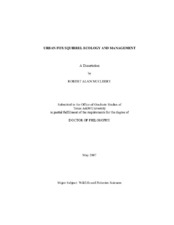| dc.contributor.advisor | Lopez, Roel | |
| dc.creator | McCleery, Robert Alan | |
| dc.date.accessioned | 2007-09-17T19:37:37Z | |
| dc.date.available | 2007-09-17T19:37:37Z | |
| dc.date.created | 2003-05 | |
| dc.date.issued | 2007-09-17 | |
| dc.identifier.uri | https://hdl.handle.net/1969.1/5908 | |
| dc.description.abstract | I studied the habitat selection, survival, and anti-predator behaviors of the fox squirrel (Siurus niger) across the urban-rural gradient in College Station, Texas. From two years of tracking the radio locations of 82 fox squirrels, my data suggested that fox squirrels in urban areas selected for use large mast bearing trees that mimicked the habitat features they prefer in non-urban areas and avoided conifer and ornamental tree species. Urban fox squirrels selected to use buildings and non-native grass during certain seasons and showed a tolerance for pavement, including it proportionally in their core-areas. Analysis of radio-telemetry data of urban and rural fox squirrels suggested that the rates of survival and causes of mortality differed between the two populations. At least 60% of the mortalities on the rural site were caused by predation, while < 5% of the mortalities on the urban site were caused by predation. Most of the mortalities on the urban site (>60%) were cause by vehicular collisions. Observations of anti-predator behaviors supported my hypothesis that squirrels decrease their anti-predator behaviors as the human presence increases. Observational data also supported my hypothesis that this phenomenon was caused by habituation. I also found that the time dedicated to anti-predator behaviors differed among urban, rural, and suburban fox squirrel populations in response to coyote and hawk vocalizations. The mean responses to both vocalizations on the rural site (coyote = 45%, hawk = 55%) were at least twice that of those found on the urban sites (coyote = 11%, hawk = 20%). I also used survey responses to questions about squirrel management to test theoretical frameworks linking attitudes to behaviors. My data suggests that beliefs and attitudes that are modified by variables shown to increase accessibility generally correspond better to behaviors. My data also suggests that the inclusion of a measure of previous behaviors will increase the predictive ability of models within different theoretical frameworks. Most importantly for the advancement of a comprehensive theoretical framework, my study showed that composite models combining components of the theory of reasoned action and attitude to behavioral process models out-performed other models. | en |
| dc.format.extent | 1113962 bytes | en |
| dc.format.medium | electronic | en |
| dc.format.mimetype | application/pdf | |
| dc.language.iso | en_US | |
| dc.publisher | Texas A&M University | |
| dc.subject | Fox Squirrel | en |
| dc.subject | Urban | en |
| dc.subject | Survival | en |
| dc.subject | Habitat | en |
| dc.subject | | en |
| dc.title | Urban fox squirrel ecology and management | en |
| dc.type | Book | en |
| dc.type | Thesis | en |
| thesis.degree.department | Wildlife and Fisheries Sciences | en |
| thesis.degree.discipline | Wildlife and Fisheries Sciences | en |
| thesis.degree.grantor | Texas A&M University | en |
| thesis.degree.name | Doctor of Philosophy | en |
| thesis.degree.level | Doctoral | en |
| dc.contributor.committeeMember | Grant, William | |
| dc.contributor.committeeMember | Sell, Jane | |
| dc.contributor.committeeMember | Silvy, Nova | |
| dc.contributor.committeeMember | Slack, R. Douglas | |
| dc.type.genre | Electronic Dissertation | en |
| dc.type.material | text | en |
| dc.format.digitalOrigin | born digital | en |


